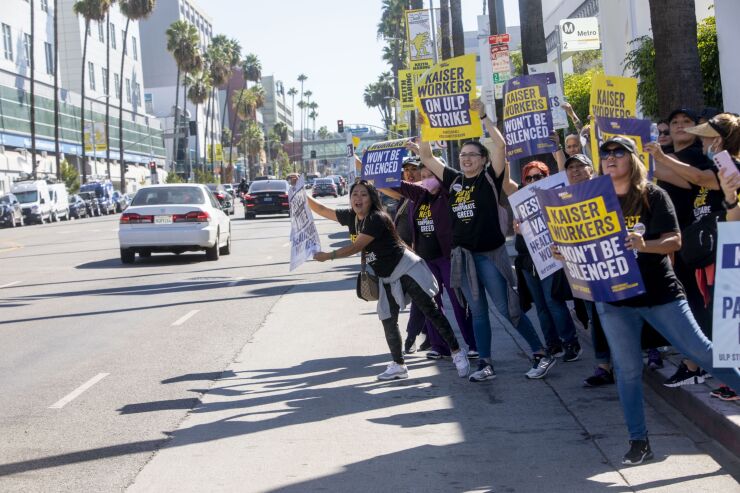The largest health-care strike in U.S. history hit Kaiser Permanente Wednesday, putting investors who buy and sell hospital bonds on edge as an industry that’s already experienced more than its share of distress struggles to stabilize financially.
Kaiser has almost $4 billion in outstanding municipal-bond debt, according to Bloomberg data, including $1 billion in so-called green bonds issued in 2017 to fund construction of LEED-certified hospitals. Kaiser operates 39 hospitals and 622 medical offices and employs almost 213,000.
Contending with soaring expenses and dwindling revenues, hospitals have been plagued with bond rating downgrades, and the debt is bearing the brunt of the defaults in what is typically a safe-haven asset class. Roughly $805.6 million of hospital debt has had some sort of distress indicator this year, the most of any other sector, according to data compiled by Bloomberg Intelligence.
Bloomberg News
Much of the financial pressures on hospitals have come from labor expenses. Doctor and nurse shortages, exaggerated by the pandemic, have driven up wages, making it exceedingly more expensive to lure and retain staff.
“Labor is the number one expense, and most critical piece, of the health care sector,” said Fitch Ratings Senior Director Kevin Holloran. “Any disruption, either in actual supply of labor or cost of labor” has a sizable impact on hospital margins, he added. “We should expect to still see difficult labor negotiations in the sector for the next several years.”
The three-day walkout by more than 75,000 Kaiser Permanente workers from California to Virginia is the latest flash point over health-care labor costs, which have soared since the onset of COVID-19 pandemic when scores of burned-out workers began leaving the field entirely. That forced hospitals to fill wards with more temporary nurses and caregivers who cost more to hire. Trade publication Becker’s Hospital review has tracked 18 hospital strikes besides Kaiser’s so far this year.
“I think the remainder of this year and into ’24, labor negotiations will be fairly contentious” for hospitals, Holloran said in an interview. “The hospitals, including Kaiser, are really in a tough position. Your revenues are effectively fixed. And 75% of your expenses are effectively variable, with the number one being labor.”
The strife comes as optimistic signs were flashing that the financial strains at American’s hospitals were easing. While operating margins are still lower than before the pandemic, they have improved this year, with a median of 1.1% year-to-date through August, according to consultant Kaufman Hall. Expenses in August rose, but so did revenue. Patient visits increased and the worst spikes in labor costs had started to stabilize.
“It’s been deterioration year after year, and now we’ve been hoping, and management has been signaling, that labor pressures are easing, but the question is, is that true?” said Jason Appleson, head of municipal bonds at PGIM Fixed Income. “Sure, we’re not hiring traveling nurses anymore. But if you’re signing big ticket employment contracts with your health-care workers, how much is labor really easing?”
Hospitals with strong balance sheets can adapt, Appleson said, while for others, granting a substantial wage increase can have a “dramatic” impact. “This is why active management is so important in the sector because it’s really a case-by-case basis,” he said.
Though spiking costs for temporary nurses drew much of the attention during the pandemic, expenses have also climbed for the lab workers, housekeepers and others who keep hospitals running and were able to take advantage of rising wages in other sectors like retail. California, where most of Kaiser’s facilities are based, last month passed a $25 minimum wage bill for health workers that awaits the governor’s signature.
Collective bargaining talks broke down on Thursday between Kaiser and its union. Workers are protesting staff shortages, stagnant pay, and other conditions they say have made it difficult to care for patients. The stoppage interrupted routine medical services for nearly 13 million people, including pharmacy orders, radiology services, and optometry. Emergency services remained open.
Under federal restrictions for health-care unions, members will have to return to the job even if no deal is reached by Saturday. The union has said it could plan additional strikes later on.
“The issues that Kaiser workers are striking over – understaffing and insufficient wages – are widespread for health care workers,” said Laurel Lucia, director of the health care program at the UC Berkeley Labor Center. “Given the increasing problems health-care workers have faced since the pandemic and the surge in strikes across industries, I would not be surprised to see more hospital strikes in the coming months.”
